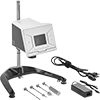Filter by
Distance Measured
Mount Type
Measuring Increments
Power Source
Manufacturer Model Number
Measures
Electrical Connection
DFARS Specialty Metals
Measurement Unit
Contact Point Length
For Use With
Measuring and Inspecting

Hour Meters
Display running time on a machine so you can schedule preventative maintenance
20 products

Optical Comparators
Magnify your part to check for dimensional accuracy and surface defects
4 products
Electrical
Fluid Handling
Containers, Storage, and Furniture
Fastening and Joining
Facility and Grounds Maintenance
Safety Equipment
Communication









































































































































